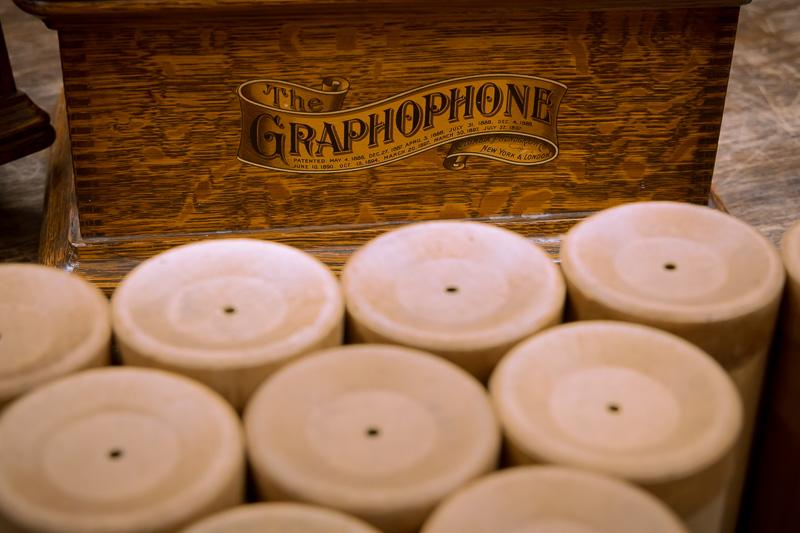Background information
Welcome to the world of old sound recordings!
On these sites, you will learn more about the oldest sound recordings, phonograms and parlograms of the SKS archive’s sound recording collection, which are dated 1904–1956.
Phonograms and parlograms represent the earliest phase of sound recording technology, acoustic analogue recording. The sound recording is created when sound vibrations are engraved on the surface of a wax cylinder with the use of either a phonograph or its improved version, a parlograph. The information contained in the cylinder can be listened to again and again. The phonograph was patented in 1877 by the man of a thousand patents, Thomas Alva Edison.
The materials of the SKS phonogram and parlogram sound record collection, herein referred to as the phonograph collection, form a whole, time-bound set. SKS’ first phonograph was acquired for the use of ethnomusicologist Armas Launis in 1905. The last parlogram cylinders included in SKS’ collections were used in Armas Otta Väisänen’s parlograph in 1956.
The SKS phonograph collection includes both cylinders and their tape copies. The contents of about 1,200 cylinders have been copied to the archive’s tapes.
The SKS collection was recorded by researchers and students of folk music and folklore, as well as Finnish, Karelian and their related languages. In addition to SKS, their background organisations and the funders of their collection works included the Kalevala Society as well as the Finno-Ugrian Society. A total of 17 persons have worked as recorders, of which four are women and thirteen are men. The project has included hundreds of folklore informants, performers and language guides.
The collection
- is a soundscape of the history of folklore, linguistics and recording
- reflects the attitudes and values of its time
- is an example of the various ways multilingualism and cultural diversity appears in the materials of the SKS archive
- includes the earliest sound records of the languages and traditions of Karelia, Finland as well as other Finno-Ugric peoples
- is a central sound recording archive for the research of folk music in its district of collecting
Background of the collection
The folk music and linguistics materials of the SKS phonograph collection
stretch from the home regions of Siberian Nenets to the northern Sámi regions.The idea of a shared past between the speakers of Finnish and other Finno-Ugric
languages was common in the research community at the time of the recording, as was the sentiment of recording the last remnants of disappearing tradition. In addition to the sound recording materials that have created a shared linguistic and cultural past, the cylinders contain evidence of the contemporary moments, ways of speaking, dialects and newer folk music at the time of recording.
The dividing line of the collection in terms of time and content of the collection was the First World War and the independence of Finland in 1917. The war closed the border between Finland and Russia, which made it difficult to arrange folklore collection trips aimed at linguistic relatives across the border. Recorder-collectors continued folklore collecting in Finland in the early 1920s with the Finnish-speaking population of Sweden and in Lapland and Estonia.
Sound samples and photographs
The sound samples of the site present different types of folk music and music from the entire district of collecting. The samples include rune singing recorded in Finland, Karelia and Värmland, Sweden, newer folk songs, pelimanni music and singing and music traditions of both distant and close related peoples. The range of languages and dialects in the samples includes, in particular, the different dialects of the Karelian and Finnish languages, as well as Inari Sámi, Nenets and Votic languages and the Seto dialect. Information about the presentation language and the language dialects are included in the sound samples. The sound recordings are mostly from field trips, but they also include material recorded for use in radio and home recordings.
The selection of the samples emphasises the diversity of contents and the presenters and language selection. Due to the combined effect of the gender emphasis of the collecting history, the varying condition of the phonograms and the emphasis on folk music, the recorders of the website’s samples are men. The performers have been selected from the best-known performers of the folk music research written in Finland and the folk music canon it supports, but the material also includes some surprises. Some of the performers have remained unknown. Our aim has been to present the “main character” of the phonographs, i.e. the phonograph, to be diversely presented in an image form.
The references of the photographs and sound recordings are available directly in connection with the materials. Any discrepancies in the dates are due to the fact that the data is based on the original reference data of different archives. This makes the location and subsequent use of materials easier. Not all recording situations have been documented by photographing either. In these cases, other applicable photographs have been used on the website.
We give thanks to all of the hundreds of singers, pelimanni musicians and language guides who performed in the SKS phonograph collection. We also give thanks to all of the researchers who made use of phonogram sets in their research and who have participated in the investigation of materials along the years, thus increasing our knowledge about early recording materials.
Enquiries: arkisto@finlit.fi

